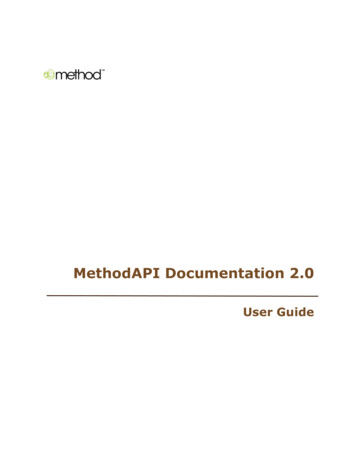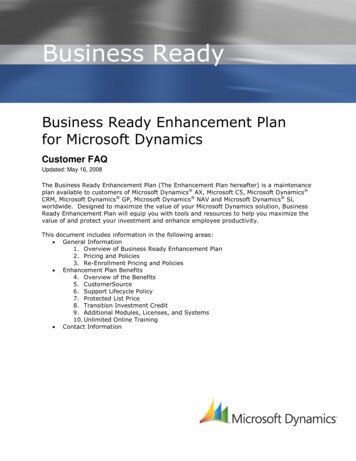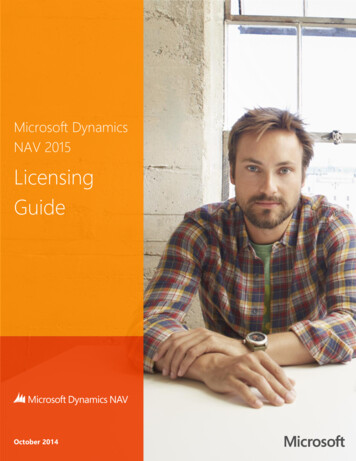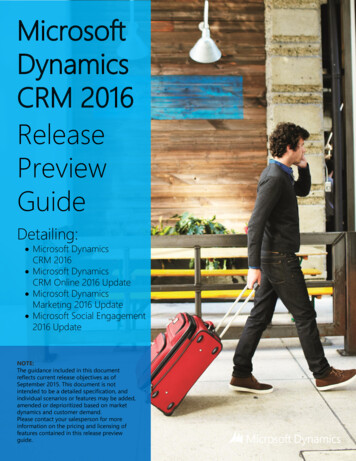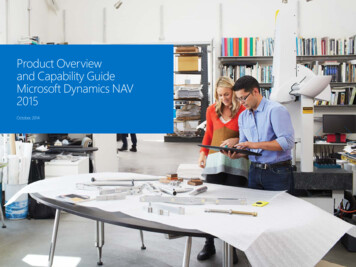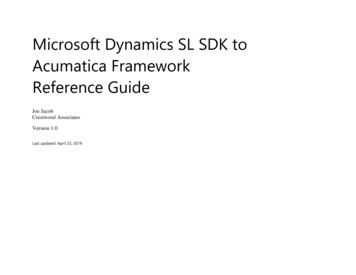
Transcription
Microsoft Dynamics SL SDK toAcumatica FrameworkReference GuideJoe JacobCrestwood AssociatesVersion 1.0Last updated: April 23, 2019
ContentsCopyright . 4Introduction . 5Cross Reference Topics ( Concepts / API Function Calls / Properties ) . 5Core Programming Language and Tools . 6CallApplic, CallApplicWait . 6First Created and Last Updated Fields . 6Typical Data Fields . 7Bound and Unbound Controls . 8Screen Grid Control . 9Key reference DLL files . 9IS TI() . 9MessBox(). 9MFirst(), MNext(), MLast() . 10NoteColumn Properly, NoteButton Properly . 10Form Control Events Handlers . 11PV Property, . 13PVChkFetch() . 13Screen Numbering . 14SDK Platforms. 14SFetch() . 15SGroupFetch() . 16SInsert(), SUpdate() . 17DBNAV() . 18
Status() . 18TranBeg(), TranEnd(), TranAbort() . 19sql() . 20SQL – BQL . 20TimeStamp usage . 20Data Access Layer . 21
Copyright 2019 Acumatica, Inc.ALL RIGHTS RESERVED.No part of this document may be reproduced, copied, or transmitted without the express prior consent of Acumatica, Inc.11235 SE 6th Street,Suite 140Bellevue, WA 98004Restricted RightsThe product is provided with restricted rights. Use, duplication, or disclosure by the United States Government is subject to restrictions as set forth in the applicableLicense and Services Agreement and in subparagraph (c)(1)(ii) of the Rights in Technical Data and Computer Software clause at DFARS 252.227-7013 orsubparagraphs (c)(1) and (c)(2) of the Commercial Computer Software-Restricted Rights at 48 CFR 52.227-19, as applicable.DisclaimerAcumatica, Inc. makes no representations or warranties with respect to the contents or use of this document, and specifically disclaims any express or impliedwarranties of merchantability or fitness for any particular purpose. Further, Acumatica, Inc. reserves the right to revise this document and make changes in itscontent at any time, without obligation to notify any person or entity of such revisions or changes.TrademarksAcumatica is a registered trademark of Acumatica, Inc. HubSpot is a registered trademark of HubSpot, Inc. Microsoft Exchange and Microsoft Exchange Server areregistered trademarks of Microsoft Corporation. All other product names and services herein are trademarks or service marks of their respective companies.
IntroductionThe purpose of this guide offers a quick reference for those already familiar with the Dynamics SL SDK and are new to the Acumatica platform. This guide will helpdirect you to the proper concepts and API’s as they relate to the expansive world of Acumatica development. It’s not meant to be a replacement for trainingcourses such as the T100, 200, and 300 series. However, it will provide a nice jump start to the training material as you move forward.For those of you coming from the Dynamics world, you will quickly see as you learn that the Acumatica design patterns are a natural progression to the evolutionof ERP technology. Additionally, and probably the most important difference between development environments, is that Dynamics SL is mostly a VB.NET languagebase whereas Acumatica is built on C#. If you are rusty in C#, don't be discouraged in the slightest. Immersing yourself in C# will just add fuel to your motivation.The guide in its present form is the first iteration of effort and will be updated in future installments. Topics we are considering adding in subsequent updatesinclude, but not limited to the following: A comparison of the SL menu system to Acumatica Site Map How reporting works in SL (Crystal Reports/FRx) vs. Acumatica Quick Queries –vs- Generic Inquires Transaction Import –vs- Import Scenario ERP Upgrades / standard practices for upgrading source codeWe expect that there will be other topics added as well. It is our sincere hope that you find this guide of great utility and your foray into the Acumatica world ofdevelopment is productive and fruitful!
Cross Reference Topics (Concepts / API Function Calls / Properties )Dynamics SLConceptDynamics SLAcumaticaCoreProgrammingLanguage andToolsCallApplic,CallApplicWaitVB.NET usingWindows FormClasses and the VBTool Kit SDK.Runs anotherapplication from anexisting screenC#, and ASP.NETBoth SL and Acumatica use various .NET frameworks depending on product release versions.A graph instance is created, the graph is filled with the found record and PXRedirectRequiredException() is used to call theASPX page.public virtual void GotoPOOrder(){var poOrdEntryGraph PXGraph.CreateInstance POOrderEntry ();var currentPoPorder ent poOrdEntryGraph.Document.Search POOrder.orderNbr (currentPoPorder.OrderNbr);if (poOrdEntryGraph.Document.Current ! null){throw new PXRedirectRequiredException(poOrdEntryGraph, true, "Purchase order Details");}}First Createdand LastUpdated FieldsCommon data fieldsto represent createdand last updatedinformation at therecord levelFields:Crtd DateTime,Crtd Prog,Crtd User,Lupd DateTime,Lupd Prog,Lupd UserThe following fields are used in many Acumatica edDateTime]
Typical DataFieldsUses DataBindingattributes forstandard .NET datatypes of String,Integer, Double, etc.Typical Columns and Data TypesValueData Type (SQL Server)Type Attribute on the Data FieldDatabase identityNatural key (for example, documentnumber)Line numberShort string (for example, a name or unitof measure)Long string (such as a description)Type or status identifier (for instance, adocument type)Boolean flag (for example,active/inactive)Price or cost, monetary unitsAmount or total, monetary unitsQuantity, piecesMaximum, minimum, or thresholdquantity, piecesPercent, rate (for example, discountpercent)Weight or volumeDateTime spanCoefficient (such as a conversion factor)Intnvarchar (15)[PXDBIdentity][PXDBString(15, IsKey true, IsUnicode true)]intnvarchar (20),nvarchar (50)nvarchar (255)int or char (1)[PXDBInt][PXDBString(20, IsUnicode true)]bit[PXDBBool]decimal (19, 6)decimal (19, 4)decimal (25, 6)decimal (9, [PXDBDecimal(2)]decimal (9, 6)[PXDBDecimal(2)]decimal (25, 6)smalldatetimeintdecimal (9, ask "t", InputMask "t")][PXDBDecimal(1)][PXDBString(255, IsUnicode true)][PXDBInt] or [PXDBString(1, IsFixed true)] respectively
Bound andUnboundControlsThe Solomon DataObject Class is usedto define the bufferwhich is associatedwith the controlobject on the form.DAC attributes for data types with a prefix of PXDB are bound, and a prefix without the DB are unbound. I.e.Bound - [PXDBString]Unbound - [PXString]Reference: Unbound Field Types
Screen GridControlWindows form control usingInterop.SAF.SAFGrid with keyproperties of DBNav, Level, etc.ASPX tag of px:PXGrid is used with references to the graph 'Views'MasterPageFile templates are used to build standard forms.Key referenceDLL lPX.ObjectsPX.DataPX.CommonIS TI()Returns a flag indicating whetheror not the application is beingautomated by TransactionImport[PXGraph].IsImport is a Boolean flag that will tell your solution that it is being referenced by Import Scenario.Other useful flags would include IsExport, IsMobile, IsContractBasedAPI and ExternalCall.Reference: Import Scenario, which is a close replacement to Transaction Box()Displays and message and waitsfor user to choose a button.[PXGraph].Ask()// Asking for confirmation on an attempt to deleteif (ShipmentLines.Ask("Confirm Delete","Are you sure?",MessageButtons.YesNo) ! WebDialogResult.Yes){e.Cancel true;}
tonProperlyMemory ArraysA DAC can be associated with a grid and a standard foreach can be used to iterate through the ‘view’Move to the first, next, or lastrecord in a designated memoryarray. Usually associated withSAFGRID control.foreach (ShipmentLine line in ShipmentLines.Select()){ }Tables with a NoteID field areused to manage text notes in SL.Acumatica supports storing notes and attaching additional objects to data records. You can attach additional objects to adata record—for instance, add a textual note or upload a file or multiple files to a data record. You enable support for datarecord attachments for each particular table individually. To enable support for data record attachments, add the columnthat stores the global data record identifier (typically, NoteID) to the table and declare the corresponding field in the dataaccess class.Note data is stored in the SNotetable.Reference: PXView Class, BQLSQL DatatypeBIGINT , nullAttribute[PXNote]Also worth noting is the ‘DeletedDatabaseRecord’ column with is a low-level mechanism for preserving deleted data recordsin the database.
Form ControlEventsHandlersVarious event handlers are usedin SL such as Chk, LineChk,Default, Update, Finish, etc.Sample Event Handler declarationprotected virtual void DACName FieldName FieldDefaulting( PXCache sender, PXFieldDefaultingEventArgs e){.}
Data Field EventsData Record EventsDatabase-Related EventsException-HandlingEventEvent for OverridingDAC Field HandlingCacheAttachedReference: Wiki Article
PV Property,PVChkFetch()Possible Value Look UpsRetrieves a composite recordfrom the database using an SQLstatement from the PV propertyof an SAFMaskedText control.DAC attribute of [PXSelector]The PV concept in Acumatica is very extensive and flexible. A DAC attribute of [PXSelector] is used and can be establishedat the DAC level and overridden at the Graph level.#region TermsIDpublic abstract class termsID : PX.Data.IBqlField{}protected String TermsID;[PXDBString(10, IsUnicode true)][PXSelector(typeof(Search Terms.termsID, Where Terms.visibleTo, Equal TermsVisibleTo.vendor , Or Terms.visibleTo,Equal TermsVisibleTo.all ), DescriptionField typeof(Terms.descr), CacheGlobal true)] Reference: PXSelectorAttribute
ScreenNumberingSL uses the(XX.999.99) formatfor screen titles.Screen numbering in Acumatica is similar:SDK Platformsa.New customscreens aredevelopedusing the SL VBTool Kit SDKwhich producecompiled EXE's.Solutions are packaged into individual customization projects controlled by the Acumatica ERP. Here are a list ofdevelopment components that can be stored:b.Modifications toexisting screenscan be doneusing aspecializeversion of VBAwith itscontents storedwithin the SLsystemdatabaseA typical solution with custom screens might include one or more DLL’s and ASPX files under the ‘Files’ section, Site Mapentries, Wikis, and reports.
SFetch()Used to retrieve acomposite recordfrom the databasebased on some predefined SQLstatement or storedprocedure.A deep dive into PXSelectBase class is vital. The PXSelect class is a multi-purpose class and can be used for ad-hoc SQLqueries.This class and other classes derived from PXSelectBase are used as a basis for building BQL statements. BQL is thentranslated into the SQL statements.Samplepublic PXSelect APPayment,Where APPayment.vendorID, Equal Required APPayment.vendorID ,And APPayment.docType, Equal Required APPayment.docType ,And APPayment.refNbr, Equal Required APPayment.refNbr APPayment VendorID DocType RefNbr;// Retrieving data records through the data view// The parameter values are taken from the adj APAdjust objectforeach (APPayment payment in APPayment VendorID DocType RefNbr.Select(adj.VendorID, adj.AdjdDocType,adj.AdjdRefNbr)){//do something with each APPayment object}The Search class can also be used within DAC attributes such as PXSelector, PXDbScalar and PXDefault for returning onefield from the database including cached values.Type of SearchSearch Field Search Field, Where Search Field, Where, OrderBy Search2 Field, Join Search2 Field, Join, Where Search2 Field, Join, Where, OrderBy Search3 Field, OrderBy Search3 Field, Join, OrderBy Search4 Field, Aggregate Search4 Field, Where, Aggregate Search4 Field, Where, Aggregate, OrderBy Search5 Field, Join, Aggregate Search5 Field, Join, Where, Aggregate Search5 Field, Join, Where, Aggregate Search6 Field, Aggregate, OrderBy Search6 Field, Join, Aggregate, OrderBy Coalesce Search1, Search2 DescriptionGets field valueGets field value with filtering by Where conditionGets field value with filtering by Where condition and orderingGets field value with filtering by using Joins with other tablesGets field value with filtering by using Joins with other tables and applying where conditionGets field value with filtering by using Joins with other tables and applying where condition andorderingGets field with ordering applicationGets field value with joins and order by applicationGets aggregated field valueGets aggregated field value with filtering by where conditionGets field value with filtering by where, aggregation and order byGets field value with application of joins and aggregatesGets field value with application of joins and where and aggregateGets field value based on join, where and aggregate conditionGets field value based Aggregate and order byGets field value based on join, aggregate and order byGets field value with using Search1 or if Search1 gives null uses Search2
Example within a DAC attribute:[PXDefault(typeof(Search PriceList.price, Where PriceList.grade, Equal Current ParkingLot.grade ))]Example within a methodDocument.Search POOrder.orderNbr (currentPoOrder.OrderNbr, currentPoOrder.OrderType);See the section on SQL-BQLSGroupFetch()Used to retrieve acomposite recordfrom the databasebased on some predefined SQLstatement or storedprocedurecontaining one ormore groupaggregate functionsand/or clauses.The PXSelectGroupBy can be used to select records from one table grouping and applying aggregations.foreach (PXResult CWBleachRecL item in PXSelectGroupBy CWBleachRecL,Where CWBleachRecL.bleachRecID, Equal Required CWBleachRecL.bleachRecID ,Aggregate GroupBy CWBleachRecL.inventoryID, GroupBy CWBleachRecL.ordNbr,Count CWBleachRecL.lineNbr .Select(this, reconID)){string ord ((CWBleachRecL)item).OrdNbr; do something}See the section on SQL-BQL
SInsert(),SUpdate()Inserts or updatesone record into eachspecified tablewithin an existingdatabase view.When forcing a save on a PXGraph a PXAction is declared and the Actions.PressSave() function can be called.public PXAction Shipment CancelShipment;[PXButton(CommitChanges true)][PXUIField(DisplayName "Cancel Shipment")]protected virtual void cancelShipment(){Shipment row Shipments.Current;row.Status ShipmentStatus.Cancelled;// Update the data record in the cache of Shipment data recordsShipments.Update(row);// Triggering the Save action to save changes in the databaseActions.PressSave();}Another option is the use of PXDatabase.UpdatePXDatabase.Update SOOrder (new PXDataFieldAssign SOOrderExt.usrRetDelStatus (PXDbType.VarChar, retDelFlag),PXDataFieldRestrict SOOrder.orderNbr (PXDbType.NVarChar, orderNumber),new PXDataFieldRestrict SOOrder.orderType (PXDbType.Char, Messages.DefaultOrderType));
DBNAV()Used to facilitatenavigation throughall database recordsin the result set ofan SQL statement.Data views are graph members that are used to retrieve and modify data records of a particular dataaccess class (DAC). You use data views:Typically used in aGRID definition.public class SalesOrderEntry : PXGraph SalesOrderEntry, SalesOrder {// Provides an interface for manipulation of sales orderspublic PXSelect SalesOrder Orders; To provide data retrieval and manipulation functions for the UI To retrieve and manipulate data from code// Provides an interface for manipulation of detail lines of the specified orderpublic PXSelect OrderLine, Where OrderLine.orderNbr, Equal Current SalesOrder.orderNbr OrderDetails; }See the section on SQL-BQLStatus()Report processstatus informationto either the ProcessStatus Window orthe Event Log orboth.The PXLongOperation is a static class that is used to execute a long-running operation, such as processing data or releasinga document, asynchronously in a separate thread. This class manages the threads created on the Acumatica ERP server toprocess long-running operations.This class also animates a spinning wheel icon and timer showing the user ‘status’ of a process.PXLongOperation.StartOperation(this, delegate(){ReleaseDocs(list);});Typically placed above the PXTransactionScope.Reference: PXLongOperation Class
TranBeg(),TranEnd(),TranAbort()Begin, end, commitsfor databasetransaction.The PXTransactionScope is used to initialize a new transaction. You can wrap-up one or more changes into a transactionand the system will revert all changes together on any exception. Do not forget to call commit for the transaction scopebefore dispose it.using (PXTransactionScope ts new PXTransactionScope()){string[] desc TranDesc desc[1];Base.Transactions.Cache.IsDirty lso see: PXLongOperation
sql()Initialize a newdatabase view.Takes the specifiedSQL text, compiles it,and then runs it.Used typically to runa stored procedure.PXDatabase.Execute() is used to execute a stored procedurevar pars new List PXSPParameter ();PXSPParameter p1 new PXSPInParameter("@prPayrollRefNbr", PXDbType.NChar, details.PayrollRefNbr);PXSPParameter p2 new PXSPInParameter("@prPayrollDetailsID", PXDbType.NChar, ayrollDetailsId", pars.ToArray());See the section on SQL-BQLSQL – BQLSL uses standardSQL statementsBQL stands from Business Query Language and is used throughout the Acumatica frameworkThe code in bold below is a sample of a BQL statement including where, and join clauses. See section 3.1 in the T200Acumatica framework fundamentals document.public PXSelectJoin SupplierProduct, LeftJoin Product, On Product.productID,Equal SupplierProduct.productID ,Where SupplierProduct.supplierID,Equal Current Supplier.supplierID SupplierProducts;TimeStampusageIn SL the fieldtstamp(timestamp, not null)is used to controlrecord locking.The SQL Field tstamp(timestamp, not null )is also used in Acumatica but with a [PXDBTimestamp] attribute in the DAC
Data AccessLayerThe Solomon DataObject Class fromthe SDK is used torepresent each SQLtable. Commonlyreferred to asbuffers.The Data Access Class know as DAC, uses an IBqlTable interphase to manage each field within a Table.It’s important to gain an understanding of how class attributes are used and how powerful they are for controlling howvarious fields behave.PXDefault, PXUIField, PXSelector, and all the possible PX data fields are typical for each field within the class.See section on Typical Data FieldsSample DAC section:[PXDBInt(IsKey true)][PXDefault][PXUIField(DisplayName "Product ID")][PXSelector(typeof(Search Product.productID Name),typeof(Product.unitPrice),SubstituteKey typeof(Product.productCD))]public virtual int? ProductID.
Microsoft Dynamics SL SDK to Acumatica Framework Reference Guide Joe Jacob Crestwood Associates Version 1.0 Last updated: April 23, 2019



